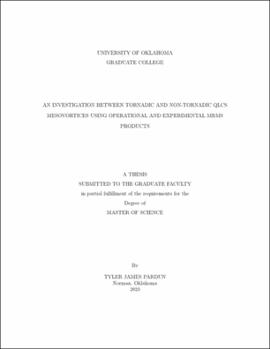| dc.description.abstract | Quasi-linear convective system (QLCS) tornadoes have become an active area of research over the last several years. Through numerical simulations, it is theorized that QLCS vortex formation occurs near the surface in a quick response to heterogeneities along the baroclinic zone at the leading edge of the system. The mechanisms responsible for the development of vorticity in the lowest tens of meters involve storm-scale processes such as downdrafts, rear inflow jets, and friction from land interactions. The Multi-Radar Multi-Sensor (MRMS) systems contain operational algorithms that can observe storm-scale dynamic features taking advantage of the quality of the WSR-88D network. Blending numerous WSR-88D radars surrounding a target QLCS can provide a more complete three-dimensional image compared to a single radar view that captures storm-scale characteristics at both the low and upper levels, blended onto a 0.01 degree latitude by 0.01 degree longitude (~1 km) and 0.005 degree latitude by 0.005 degree longitude (~500 m) horizontal grid space. This study highlights testing of currently operational (e.g., dual-pol products and azimuthal shear) and experimental MRMS products (e.g., divergent shear and total shear) that aid in detecting QLCS meso-gamma-scale (2–40 km) vortices and subsequent tornadoes in both the pre-tornadic and tornadic phases.
A total of 107 tornadic and 139 non-tornadic mesovortices are examined over 13 QLCS events spanning from 2019 through 2022. It was found that tornadic mesovortices often display deep, transient plumes of significantly enhanced cyclonic shear relative to non-tornadic mesovortices during the pre-tornadic phase. Further, signals displaying a significantly higher magnitude of mid-to-upper level divergence and low-to-mid level specific differential phase (KDP) is illustrated, indicative of transient precipitation-loaded updraft pulses manifesting during the hour prior tornadogenesis. Additionally, the ambient environment in which tornadic mesovortices manifest are characterized with steeper most unstable lifted condensation level (MULFC) lapse rates and higher surface-based CAPE relative to their non-tornadic counterpart. Higher 0–3 km AGL and 0–6 km AGL are also evident in tandem with higher 0–1 km AGL and 0–3 km AGL storm relative helicity (SRH). Non-tornadic mesovortices are often characterized with a higher magnitude of cyclonic shear and convergent shear at the near-surface relative to their tornadic counterpart during the period prior to their peak in 0–1 km AGL layer-maximum azimuthal shear. High variability and significant overlap in the interquartile range exists for all operational and experimental products for all tornadic and non-tornadic mesovortices retained in the dataset, indicating that the processes involved in QLCS tornado formation can vary on a case-by-case basis.
A total of 107 tornadic and 139 non-tornadic mesovortices are examined over 13 QLCS events spanning from 2019 through 2022. It was found that tornadic mesovortices often display deep, transient plumes of significantly enhanced cyclonic shear relative to non-tornadic mesovortices during the pre-tornadic phase. Further, signals displaying a significantly higher magnitude of mid-to-upper level divergence and low-to-mid level specific differential phase (KDP) is illustrated, indicative of transient precipitation-loaded updraft pulses manifesting during the hour prior tornadogenesis. Additionally, the ambient environment in which tornadic mesovortices manifest are characterized with steeper most unstable lifted condensation level (MULFC) lapse rates and higher surface-based CAPE relative to their non-tornadic counterpart. Higher 0–3 km AGL and 0–6 km AGL are also evident in tandem with higher 0–1 km AGL and 0–3 km AGL storm relative helicity (SRH). Non-tornadic mesovortices are often characterized with a higher magnitude of cyclonic shear and convergent shear at the near-surface relative to their tornadic counterpart during the period prior to their peak in 0–1 km AGL layer-maximum azimuthal shear. High variability and significant overlap in the interquartile range exists for all operational and experimental products for all tornadic and non-tornadic mesovortices retained in the dataset, indicating that the processes involved in QLCS tornado formation can vary on a case-by-case basis. | en_US |
